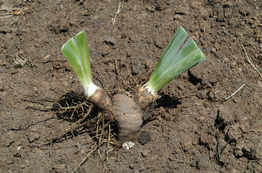Dividing Iris

Iris are one of the easiest perennial plants to grow, providing abundant beauty through the home landscape. While Iris are easy to care for, they can quickly outgrow their space, and if they are crowded, the plants won’t bloom very well. It’s best to divide this plant every three to five years to encourage vigorous blooms. The best time to divide Iris is from mid-July through early-August when they are dormant for the summer.
The root system of Iris consists of thick rhizomes (horizontal underground stems) with smaller shallow feeder roots. It’s best to dig up a clump of iris, then divide and reset the plants. Use a sharp knife to cut the rhizomes apart so each division consists of at least one fan of leaves and a section of rhizome. If possible, leave two fans per rhizome, similar to the photo above, as these “double fans” will produce more flowers in the first year after planting. Divisions with a single fan will still bloom; however, it will take them a year before they have as many flowers as a double fan.
Before replanting your iris divisions, inspect the rhizome for disease or damage and discard any pieces that show signs of borers or soft rot. You can remove borers from a rhizome if you wish or treat for soft rot by scraping the affected tissue, letting it dry, then dipping it in a 10% bleach solution. Once you have divided the iris, cut the leaves back by two-thirds before replanting. Plant iris 12-18” apart, closer for dwarf varieties, so the top of the rhizome is still visible above the surface.
If possible, do a soil test before planting, as it’s easier to add amendments to the soil while the irises are dug up versus after planting them. If you don’t do a soil test, add a complete fertilizer into the soil and mix it to a depth of 6 inches. If you have been fertilizing the bed regularly, it’s best to do a soil test, as excessive nutrients could be building up in the soil if you have been using a complete fertilizer for several years. Make sure to water your iris in after planting and water as needed while they are getting reestablished in that bed. This video shows how to divide iris and what the plants look like several years later: https://kansashealthyyards.org/all-videos/video/dividing-iris

Have questions? Contact our office where our Horticulture Extension Agent will assist you with questions.
Phone: (316) 321-9660
Email: callae@ksu.edu